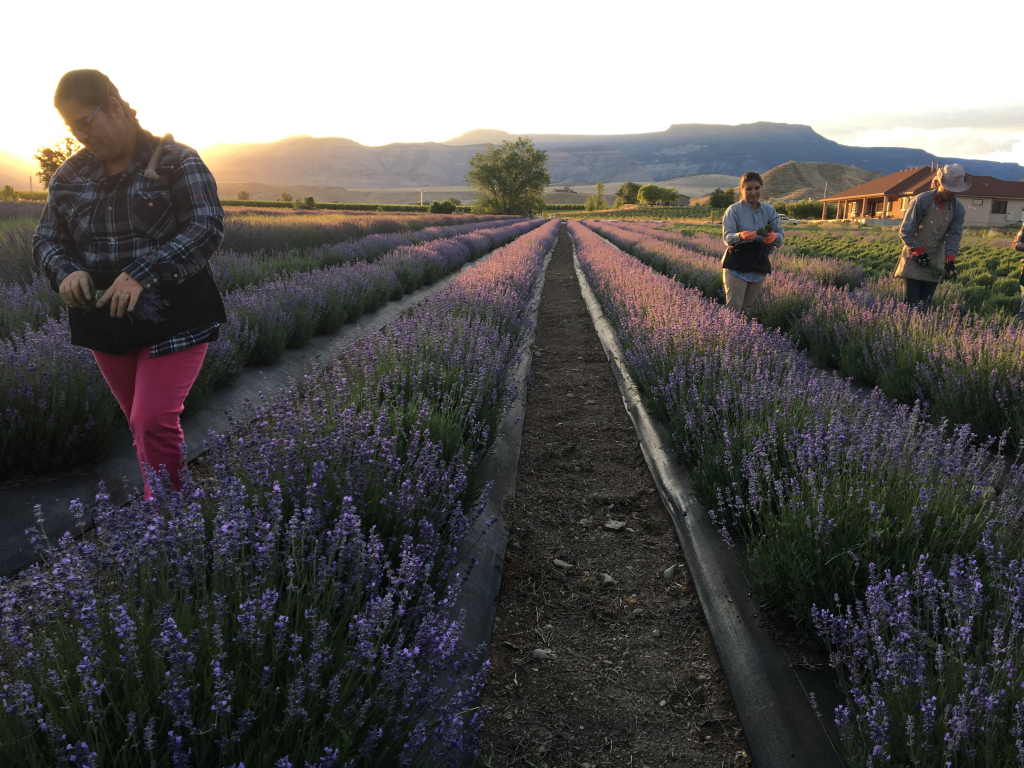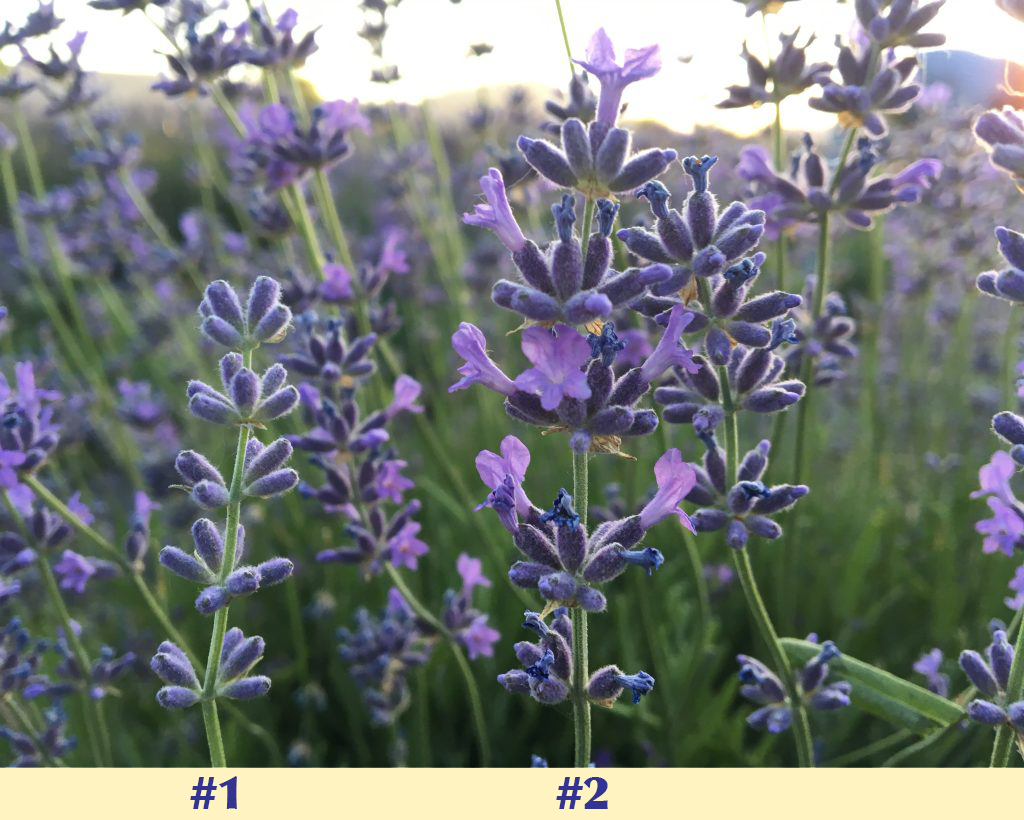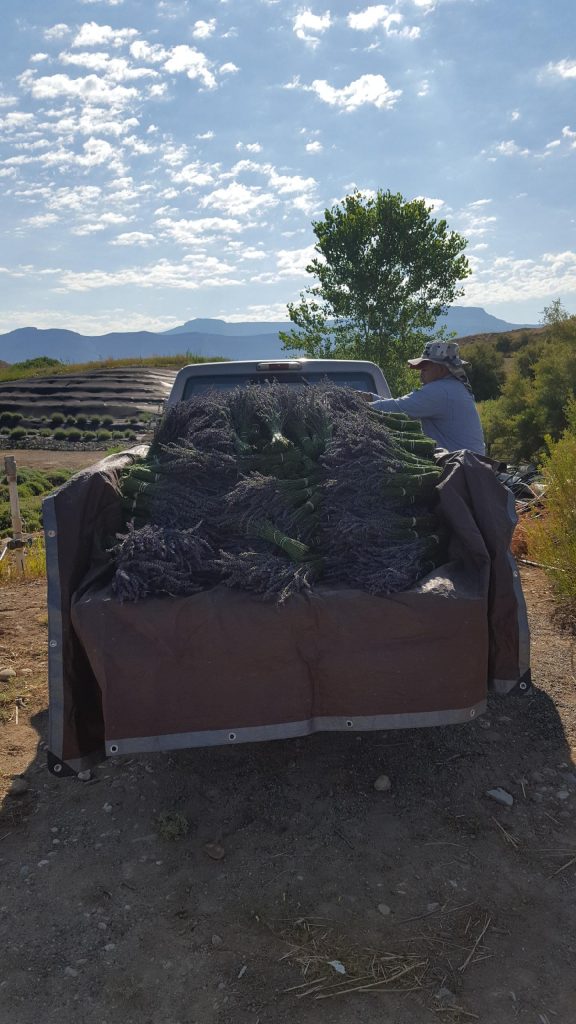As you know from our last blog post, lavender harvest is a special occasion. It comes once a year, and though it’s somewhat of a frantic time for us here at the farm, it’s certainly an occasion worth celebrating.
So much goodness comes out of harvesting lavender. Enjoying beautiful sunrises, taking in sweet and uplifting smells, connecting to the land, participating in the bounty of plant medicine…
Harvesting lavender offers a plethora of benefits. It’s also definitely a skill.
And it’s one you can learn.

Phase One: Knowing when to harvest is the half of it.
No matter what you intend to use lavender for, harvesting it at the right time is essential to creating a high-quality product. By watching your lavender plants grow and transform throughout the season, you’ll develop a sense as to when the time is right for harvesting.
As weather warms in the spring (and after a nice spring pruning), lavender plants begin to send up stems and tightly closed spikes.

Buds form on the spikes and grow, eventually changing from green to a greenish hue of lavender (or white, or blue, or pink…). Then, the flowers (corolla) emerge from the buds – The lavender is blooming.
Not all buds on the same spike bloom at once. Look at these two spikes, for example:

Sprig #1 has closed buds, while Sprig #2 is blooming and ready for harvest
These sprigs of lavender are from the same plant.
#1 is still “green”, meaning it’s too early to harvest. Notice how its buds are completely closed, and they still have a translucent, greenish hue.
#2 is ready to be harvested. Some of its buds are in full bloom, and many others (the buds with the dried, blue-violet petals on their tips) have already bloomed.
Generally, you want to harvest a stem of lavender when about half of the buds are in bloom.
Of course, you may not be inclined to harvest lavender stem by stem. You can approach your lavender plants in sections, harvesting parts of the plant at various times, when each part is at its peak bloom.
You can also consider what you’ll be using lavender for to determine the right time to harvest. For example:
- When harvesting lavender for essential oil distillation, wait until 50%-100% of the buds are blooming.
- When harvesting lavender for dried buds to use in potpourri, sachets or culinary uses, harvest when 25%-50% of the buds are blooming.
Those of us out there who are methodically-minded can try this approach: Take a random sample of about 20 stems of lavender to determine the general openness/readiness of a plant or a section of plants.
Phase Two: Understanding the basics, then learning from experience.
Now that you have an idea of what you’re looking for, you can grab your scissors – or your hand sickle – and get out there. The best way to learn is by doing. The more time you spend around your lavender plants, the more you’ll begin to pick up on their subtleties.
Cut low so that you get long stems, but don’t cut into the woody base of the plant, as this will stunt new growth next year.
Bring rubber bands so that you can make bundles of lavender as you harvest, which you can enjoy fresh or hang upside-down in a cool, dark place to dry. You can pull off some of the leaves as you harvest to speed up the drying process.

Freshly harvested Folgate lavender
And of course, you always want to harvest in the early morning, before the heat arrives. Lavender loses its oil to the heat of the day, so harvesting in the cool of the morning (before 10am) you’ll harvest lavender with a higher oil content.
With a little practice and observation, you’ll be a skilled lavender harvester in no time.

True Grosso in bloom as the sun rises


Nancy
Love your newsletter and share it every month.
Leonard
Very informative and I will try this advice on our plants!
Steve
How long do you dry, or what do I look for to know the plant is dry and ready for distillation.
janice routon
HI,
In zone 7a when would you harvest lavender \I understand you can plant from march to may.
Thank you,
Janice Routon
Gemma Stockham
Hi Sage Creations
I have a wonderfully large Lavendar bush in my front garden and now the bees have had their fun and taken the pollen they need and the flowers are spent i am left with just the lavendar buds. Can i harvest these to make Lavendar scrubs or oils or have they gone past their best?
Kind regards
Gemma
Virginia
Thank you for the info that removes the guesswork! I fell in love with lavender a few years ago and synchronistically the home I moved to 2years ago have several plants. I am always looking for new ideas to create skin care products and artistic projects as well. I am learning more as the harvest time comes and your information is really helpful!
Bruce Everett
Once the stems are cut, how long can you wait before distillation?
houghton
Hі there, just wanted to say, I loved this blog pⲟst.
It was helpful. Keep οn poѕting!
Sandra Bush
Super helpful Thank you!